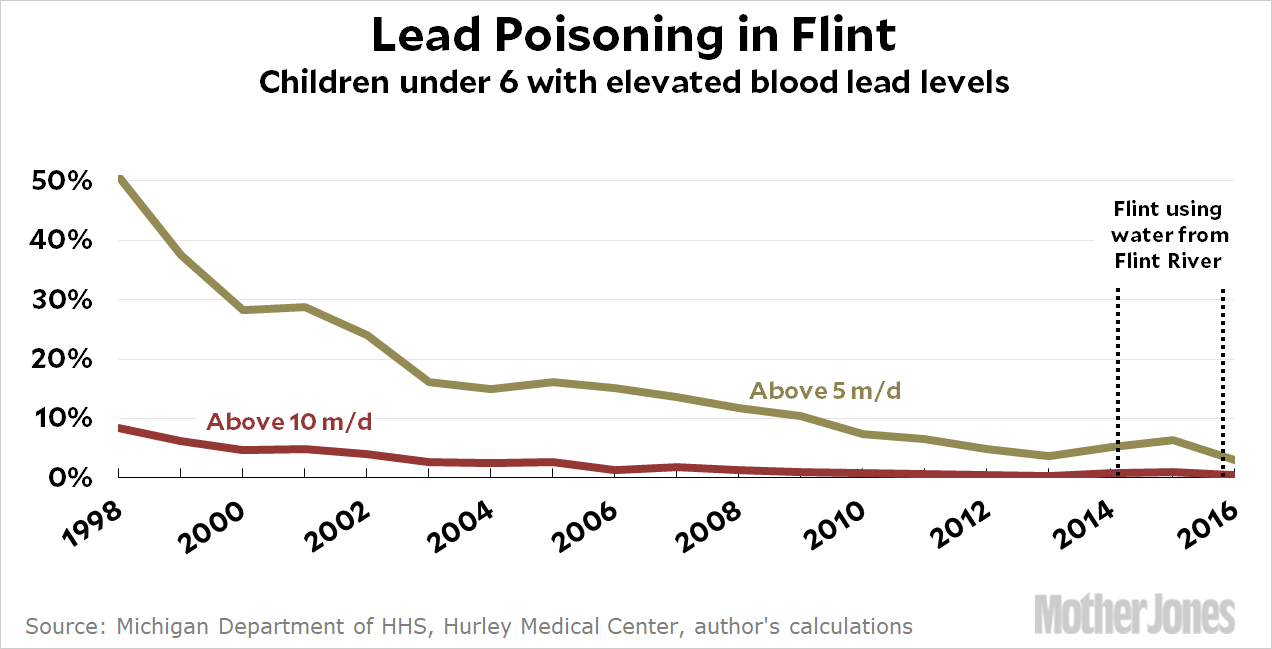Someone with real expertise in the field of lead poisoning has finally worked up the courage to tell the truth in public about the lead in Flint’s water:
Words are toxic, too. Labeling Flint’s children as “poisoned,” as many journalists and activists have done since the city’s water was found to be contaminated with lead in 2014, unjustly stigmatizes their generation.
….The Centers for Disease Control and Prevention now considers a blood lead level in children of 5 micrograms per deciliter and higher to be a “reference level.” This measure is intended to identify children at higher risk and set off communitywide prevention activities. It does not suggest that a child needs medical treatment. In fact, the C.D.C. recommends medical treatment only for blood lead levels at or above 45 micrograms per deciliter. Not a single child in Flint tested this high. This was a surprise for several visiting celebrities, who requested a visit to the “lead ward” of Hurley Children’s Hospital.
….We found that levels did increase after the water switched over in 2014, but only by a modest 0.11 micrograms per deciliter. A similar increase of 0.12 micrograms per deciliter occurred randomly in 2010-11. It is not possible, statistically speaking, to distinguish the increase that occurred at the height of the contamination crisis from other random variations over the previous decade.
….It is therefore unfair and inaccurate to point a finger at Flint and repeatedly use the word “poisoned.” All it does is terrify the parents and community members here who truly believe there may be a “generation lost” in this city, when there is no scientific evidence to support this conclusion.
This comes from Hernán Gómez and Kim Dietrich. I don’t personally know Gómez, but I’ve spoken with Dietrich several times and there’s no one on earth more concerned about the effect of lead on children than he is. Nevertheless, facts are facts. As a political catastrophe, Flint ranks very high indeed, but as an environmental catastrophe its effects are fairly limited. The lead level in the water increased by a modest amount for a modest time, and the result was modestly elevated blood lead levels for a short time. That’s a terrible thing that should never have happened, but the actual impact is still small. We’re talking about maybe a loss of one IQ point or a change in aggression of 1 percent.

Basically, with a tiny handful of exceptions, the kids of Flint are fine. In the end, the panic might end up doing the kids more harm than the lead. If teachers and parents give up because they think an entire generation of children is doomed, then we really will have a generation of childen that’s doomed. If the kids themselves grow up “knowing” that their brains have been permanently poisoned, how many of them will just give up and decide that trying in school isn’t worth it?
I understand the quandary here. If you don’t yell and scream, nobody will do anything. The squeaky wheel gets the grease. But if you do yell and scream and keep it up forever, you convince an awful lot of kids that they’re hopelessly simpleminded and will never amount to anything. That’s worse than the effects of the lead itself.













